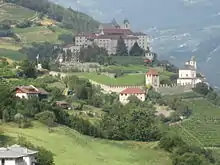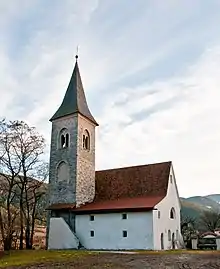Brixen
Brixen (German pronunciation: [ˈbrɪksn̩]; Italian: Bressanone [bressaˈnoːne]; Ladin: Porsenù or Persenon) is a town in South Tyrol in northern Italy, located about 40 kilometres (25 mi) north of Bolzano.
Brixen
Bressanone | |
|---|---|
| Gemeinde Brixen Comune di Bressanone | |
 | |
 Coat of arms | |
Location of Brixen Bressanone 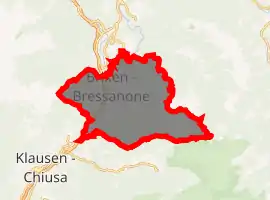
| |
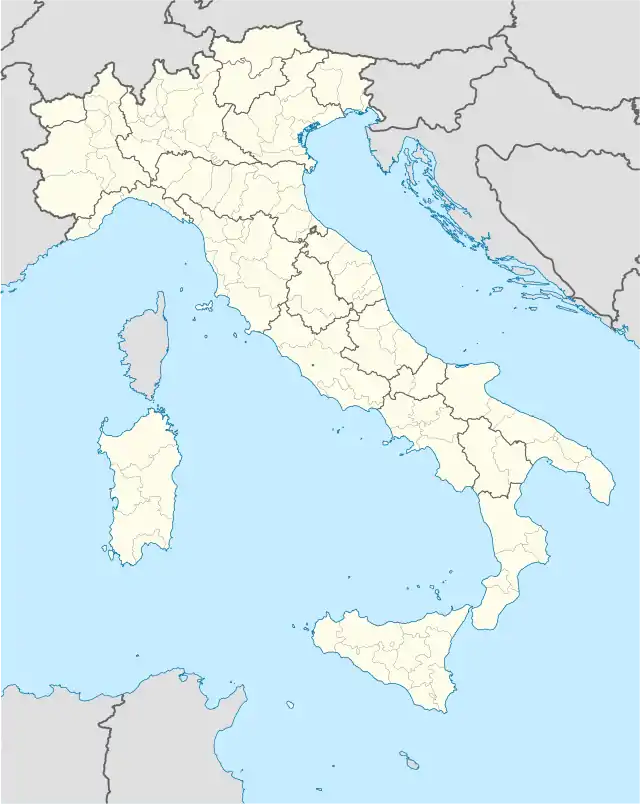 Brixen Bressanone Location of Brixen Bressanone in Italy 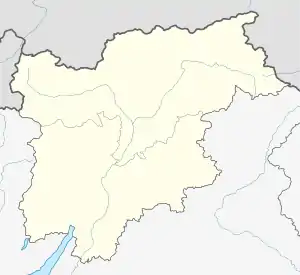 Brixen Bressanone Brixen Bressanone (Trentino-Alto Adige/Südtirol) | |
| Coordinates: 46°43′N 11°39′E | |
| Country | Italy |
| Region | Trentino-Alto Adige/Südtirol |
| Province | South Tyrol (BZ) |
| Frazioni | see list |
| Government | |
| • Mayor | Peter Brunner |
| Area | |
| • Total | 84.86 km2 (32.76 sq mi) |
| Elevation | 560 m (1,840 ft) |
| Population (31 August 2015)[2] | |
| • Total | 21,416 |
| • Density | 250/km2 (650/sq mi) |
| Demonyms | German: Brixner Italian: brissinesi |
| Time zone | UTC+1 (CET) |
| • Summer (DST) | UTC+2 (CEST) |
| Postal code | 39042 |
| Dialing code | 0472 |
| Patron saint | Saint Albuin Saint Ingenuin |
| Saint day | February 2 |
| Website | Official website |
Geography
First mentioned in 901, Brixen is the third largest city and oldest town in the province, and the artistic and cultural capital of the valley. It is located at the confluence of the Eisack and Rienz rivers, 40 kilometres (25 mi) north of Bolzano and 45 kilometres (28 mi) south of the Brenner Pass, on the Italy-Austrian border. It is flanked on the eastern side by the Plose and Telegraph (Monte Telegrafo) mountains (2,504 m) and on the western side by the Königsanger (Monte Pascolo) (2,436 m) mountain.
Brixen is especially known as a major skiing resort (the Plose). Other activities include hydroelectric power, orchards, and vineyards.
Frazioni
Frazioni / incorporated villages: Afers (Eores), Albeins (Albes), Elvas, Gereuth, Karnol, Klerant (Cleran), Kranebitt (Costa d'Elvas), Mahr (La Mara), Mairdorf, Mellaun (Meluno), Milland, Pairdorf (Perara), Pinzagen (Pinzago), Plabach, Rutzenberg, St. Andrä (S.Andrea), St. Leonhard (S.Leonardo), Sarns (Sarnes), Tils (Tiles), Tötschling (Tecelinga), Tschötsch (Scezze), Untereben.
History
The area of Brixen has been settled since the Upper Paleolithic (8th millennium BC). Other settlements from the late Stone Age have been found and in 15 BC, the area was conquered by the Romans, who had their main settlement in the nearby Säben (Sabiona). They held it until around 590, when it was occupied by Bavarians.
The first mention of Brixen dates to 901 in a document issued by the King of Germany, Louis III the Child, in it a territory called Prihsna is assigned to Zacharias, bishop of Säben. As time passed, "Prihsna" turned into the current name of Brixen. The bishops moved here from Säben in 992, after the Cathedral had been finished.
In 1039, the Bishop of Brixen, Poppo, was elevated to Pope by emperor Henry III. However his reign lasted for only 23 days. In the same century, Brixen became the seat of an independent ecclesiastical principate which, in the following years, struggled for existence against the neighbouring county of Tyrol. In 1080, the synod of Brixen condemned Pope Gregory VII. In 1115, a first line of walls encircling Brixen was completed.
The bishopric was secularized in 1803 and annexed by the Austrian Empire. Between 1851 and 1855, the Czech journalist and writer Karel Havlíček Borovský was exiled by the Austrian government to Brixen. After the end of World War I, Brixen was annexed by Italy.
Coat-of-arms
The oldest coat of arms dates back to 1297 with the lamb, known then from 1304 as a symbol of the lamb. On 13 November 1928, a shield with the city walls and a gate on the lawn in the upper half and the lamb in the lower was adopted. The emblem is a turned argent lamb with an or halo on a gules background; the right foreleg supports a flag with a gules cross. The emblem was granted in 1966.[3]
Main sights
- The Cathedral (10th century), dedicated to Santa Maria Assunta, was rebuilt in the 13th century and again in 1745–54 along Baroque lines. The ceiling of the nave has a large fresco by Paul Troger portraying the Adoration of the Lamb.
- The Hofburg, a Renaissance Bishop's Palace (started in the 13th century), one of the main noble residences in South Tyrol. The Diocesan Museum has several artworks, including a presepe with 5,000 figures created for Bishop Karl Franz Lodron.
- The round parish church of Saint Michael (11th century). The Gothic choir and the bell tower are from the 15th century while the nave is from the 16th. The main artwork is a wooden Cireneus from the 15th century.
- The Pharmacy Museum (Pharmaziemuseum Brixen), located in a nearly 500-year-old townhouse, shows the development and changes of the local pharmacy. The Peer family (now the 7th generation) has run this pharmacy since 1787, always in the same location. The museum's carefully restored rooms illustrate the development of the pharmaceutical profession over the centuries and the changes in remedies used, from the testicles of a beaver and pieces of an ancient Egyptian mummy to modern plasters and lyophilisates. All the objects and medicines on display were in use over the centuries. The Museum also has a library for historical research and the archive of the Peer family. In a separate room there is a multimedia display of the history of the family.
- The White Tower (also known as "Weißer Turm") was completed in 1591, but subsequently modified. The 72 meter tall tower, which is located next to the parish church of Saint Michael, is inside the city walls in the historic center of Brixen.[4] It contains a complex carillon mechanism of 43 bells, which ring every day at 11.00 a.m. and can play more than a hundred different tunes.[5] On the top floor there is a large roof where it is possible to observe the circumstances. The Tower also has a lunar clock. The architecture of the tower belongs to the Gothic Architecture and is one of the few remaining in South Tyrol. It is the cultural heritage monument with the number 14186 in South Tyrol. The White Tower is used as a museum since 2007.[6]
Outside the city is Rodeneck Castle, one of the most powerful of its time. It has precious frescoes from the early 13th century. Also important are Reifenstein Castle and Trostburg Castle in Waidbruck. In the latter lived the adventurer and minstrel Oswald von Wolkenstein.
Gallery
.jpg.webp) Cathedral of Brixen
Cathedral of Brixen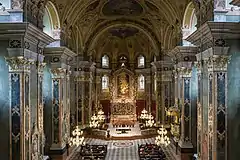 Inside the cathedral
Inside the cathedral Hofburg Brixen
Hofburg Brixen
Society
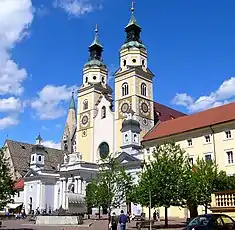
Linguistic distribution
According to the 2011 census, the majority of the population speaks German as first language (72.82%). The remainder of the inhabitants speak Italian and Ladin as first languages, with percentages of 25.84% and 1.34%, respectively.[7]
| Language | 2001[8] | 2011[7] |
|---|---|---|
| German | 73.13% | 72.82% |
| Italian | 25.65% | 25.84% |
| Ladin | 1.23% | 1.34% |
Notable people
- Maria Hueber (1653-1705) a religious sister, a pioneer in educating girls in the Tyrol
- Matteo Goffriller (1659–1742) a Venetian luthier, particularly noted for the quality of his cellos
- Anton Pichler (1697–1779) a Tyrolean goldsmith and artist of engraved gems
- Jakob Philipp Fallmerayer (1790–1861) Tyrolean traveller, journalist, politician and historian
- Johanna von Isser Großrubatscher (1802-1880) graphic artist and writer
- Josef Murr (1864–1932) classical philologist and botanist
- Eduard Thöny (1866-1950) caricaturist and illustrator
- Fritz Tarbuk von Sensenhorst (1896–1976) lieutenant in the Austro-Hungarian Navy, captain in the army and an entrepreneur
- Mary de Rachewiltz (born 1925) poet and translator
- Reinhold Messner (born 1944) mountaineer, adventurer, explorer, author and politician
- Heinz Winkler (born 1949) three-Michelin star chef.
- Herbert Dorfmann (born 1969) agronomist and Member of the European Parliament
- Sport
- Denise Karbon (born 1980) World Cup alpine ski racer
- Karin Oberhofer (born 1985) biathlete, bronze medallist in the Mixed relay at the 2014 Winter Olympics
Transport
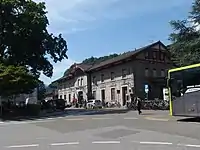
Brixen has a railway station on the Brenner Railway, which connects the town to Verona and Innsbruck. It has an individual fare structure for public transport within the Tirol-Südtirol zone.
Italy
- Regional Train (Trenitalia Regional): Brennero/Brenner - Fortezza/Franzensfeste - Bressanone/Brixen - Chiusa/Klausen - Bolzano/Bozen - Trento - Rovereto - Verona - Isola della Scala - Nogara - Bologna
Germany/Austria/South Tyrol
(D for Germany, A for Austria)
On 11 December 2016, ÖBB will take over Deutsche Bahn's night trains. The Munich-Milan service will be withdrawn.
- Night Train (DB CityNightLine) Munich-Milan/Rome: Munich (D) - Kufstein (A) - Jenbach (A) - Innsbruck (A) - Brixen/Bressanone - Bolzano/Bozen - Trento/Trient - Verona - Peschiera del Garda - Brescia - Milan
- Intercity Train (ÖBB Eurocity) Munich-Verona/Venice: Munich (D) - Kufstein (A) - Jenbach (A) - Innsbruck (A) - Brenner/Brennero - Franzensfeste/Fortezza - Brixen/Bressanone - Bolzano/Bozen - Trento - Rovereto - Verona - Padua - Venice
- Intercity Train (ÖBB Eurocity) Munich-Verona/Bologna: Munich (D) - Kufstein (A) - Jenbach (A) - Innsbruck (A) - Brenner/Brennero - Franzensfeste/Fortezza - Brixen/Bressanone - Bolzano/Bozen - Trento - Rovereto - Verona - Bologna
- Regional Train (Südtirol Bahn Regio-Express) Bolzano/Bozen-Innsbruck: Bolzano/Bozen - Brixen/Bressanone - Franzensfeste/Fortezza - Sterzing/Vipiteno - Brenner/Brennero - Innsbruck
- Regional Train (Südtirol Bahn Regio) Brixen/Bressanone-Lienz: Brixen/Bressanone - Franzensfeste/Fortezza - Mühlbach/Rio di Pusteria - Vintl/Vandoies - Ehrenburg/Casteldarne - St. Lorenzen/San Lorenzo di Sebato - Bruneck/Brunico - Olang/Valdaora - Welsberg/Monguelfo - Niederdorf/Villabassa - Toblach/Dobbiaco - Innichen/San Candido - Lienz (A)
- Train connects at Verona with ÖBB EuroNight Rome-Vienna: DB CityNightLine splits into two trains (first half couples with ÖBB Rome-Vienna and leaves for Vienna or Rome; second half continues to Munich or Milan). Vienna-Rome splits into two trains (first half continues to Rome or Vienna; second half couples with DB CityNightLine for Milan or Munich).
By road, the town has two exits on the Brenner Autobahn that connects Brixen to the Brenner Pass.
Twin towns - sister cities
Brixen is twinned with:[9]
 Bled, Slovenia, since 2004
Bled, Slovenia, since 2004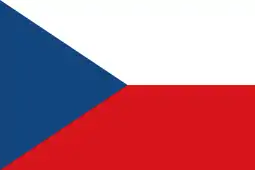 Havlíčkův Brod, Czech Republic, since 1992
Havlíčkův Brod, Czech Republic, since 1992 Regensburg, Germany, since 1969
Regensburg, Germany, since 1969
Sports
- Brixen hosted the 2009 World Youth Championships in Athletics.
- Brixen hosted the 16th Unicycle World Convention and Championships (UNICON) in July 2012.
References
| Wikisource has the text of the 1911 Encyclopædia Britannica article Brixen. |
- "Superficie di Comuni Province e Regioni italiane al 9 ottobre 2011". Istat. Retrieved 16 March 2019.
- "Popolazione Residente al 1° Gennaio 2018". Istat. Retrieved 16 March 2019.
- Heraldry of the World: Brixen-Bressanone
- "St.-Michaelstor / Weißer Turm - Brixen, Trentino-Alto Adige, Italy - Signs of History on Waymarking.com". www.waymarking.com. Retrieved 2020-11-17.
- "Glockenspiel Weißer Turm - Brixen, Trentino-Alto Adige, Italy - Carillon on Waymarking.com". www.waymarking.com. Retrieved 2020-11-17.
- "Brixner 179 - Dezember 2004". Issuu. Retrieved 2020-11-17.
- "Volkszählung 2011/Censimento della popolazione 2011". Astat Info. Provincial Statistics Institute of the Autonomous Province of South Tyrol (38): 6–7. June 2012. Retrieved 2012-06-14.
- Oscar Benvenuto (ed.): "South Tyrol in Figures 2008", Provincial Statistics Institute of the Autonomous Province of South Tyrol, Bozen/Bolzano 2007, p. 16, table 10
- "Città gemellate". brixen.it (in Italian). Brixen. Retrieved 2019-12-18.
Further reading
- Ludwig Tavernier, Der Dombezirk von Brixen im Mittelalter. Gestalt, Funktion, Bedeutung (= Schlern-Schriften 294). Innsbruck: Universitätsverlag Wagner 1996. ISBN 3-7030-0266-2
- Leo Andergassen, Der Dom zu Brixen. Geschichte, Raum, Kunst. Bozen: Verlagsanstalt Athesia 2009. ISBN 978-88-82665975
- Helmut Flachenecker, Hans Heiss, Hannes Obermair (eds), Stadt und Hochstift, Brixen, Bruneck und Klausen bis zur Säkularisation 1803 – Città e Principato, Bressanone, Brunico e Chiusa fino alla secolarizzazione 1803 (= Veröffentlichungen des Südtiroler Landesarchivs 12). Bozen: Verlagsanstalt Athesia 2000. ISBN 88-8266-084-2
- Barbara Fuchs, Hans Heiss, Carlo Milesi, Brixen. Die Geschichte. Kunst, Kultur, Gesellschaft. 2 vols. Bozen: Athesia/Tappeiner 2004–06
External links
![]() Media related to Brixen at Wikimedia Commons
Media related to Brixen at Wikimedia Commons
- (in German and Italian) Homepage of the municipality
- Photos from Brixen
- WebCam picture from Bressanone - Brixen
